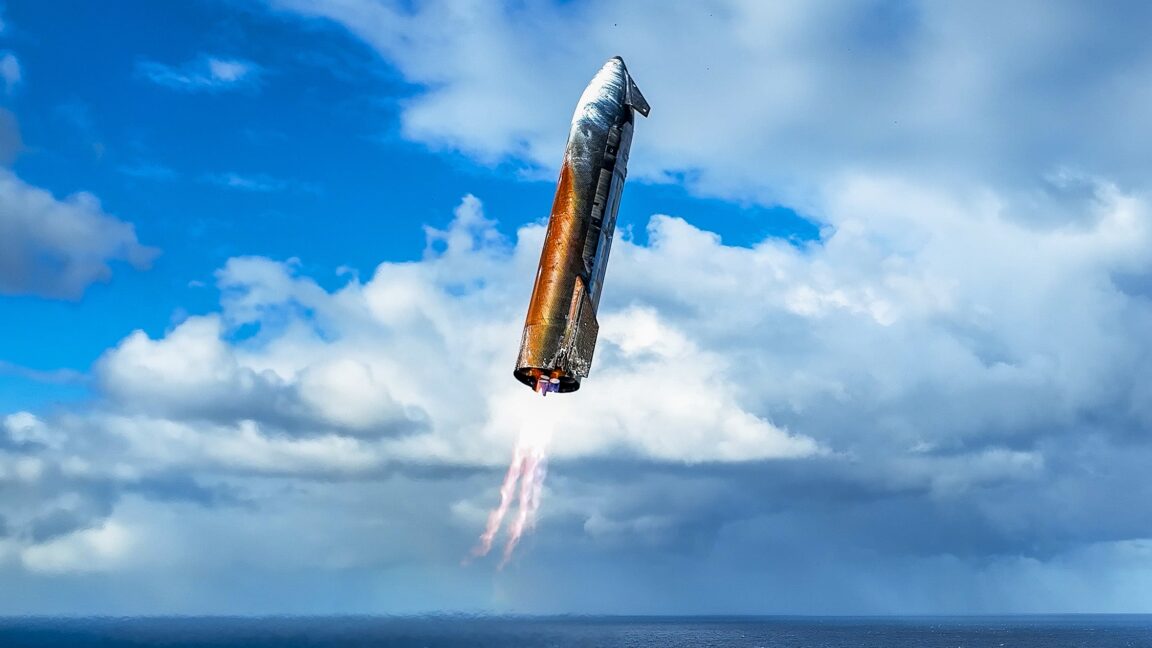Science
SpaceX Identifies Key Heat Shield Improvements After Starship Test

SpaceX has identified critical improvements for its Starship heat shield following the spacecraft’s recent test flight on August 26, 2023. The company’s engineers confirmed that sealing the tiles on the heat shield is essential for enhancing performance in future missions. Bill Gerstenmaier, the SpaceX executive overseeing build and flight reliability, shared these insights during a presentation at the American Astronautical Society’s Glenn Space Technology Symposium in Cleveland.
The Starship successfully launched from SpaceX’s facility in Starbase, Texas, marking the 10th complete test flight of the Super Heavy booster and Starship upper stage. As the world’s largest rocket, the mission aimed to address propulsion and propellant issues that had affected prior flights. Gerstenmaier noted that the test flight provided valuable data regarding the heat shield, which consists of thousands of tiles designed to protect the vehicle during atmospheric reentry.
“Things went extremely well,” Gerstenmaier remarked, highlighting the Starship’s controlled splashdown in the Indian Ocean, just northwest of Australia. The spacecraft landed within 10 feet (3 meters) of its intended target, demonstrating improved accuracy. However, post-flight assessments revealed visible damage, including a rusty orange discoloration along the vehicle’s side, attributed to oxidation of experimental metallic tiles.
Elon Musk, SpaceX’s founder, indicated that the discoloration resulted from testing metal tiles alongside the ceramic tiles typically used for heat shielding. Gerstenmaier elaborated on the findings, explaining the shortcomings of the metallic tiles. “The metal tiles didn’t work so well. They oxidized extremely nice in the high oxygen environment,” he said. This revelation underscores the ongoing experimentation within SpaceX’s design process, as the company seeks to refine its technology swiftly.
Gerstenmaier’s extensive background, including a tenure at NASA, allows him to convey complex technical concepts in an understandable manner. He emphasized the importance of developing a durable heat shield for Starship to facilitate rapid reusability. Musk has expressed ambitions for reusing Starships within 24 hours, a goal that requires a reliable heat shield capable of withstanding extreme conditions during launch and reentry.
During the presentation, Gerstenmaier pointed out areas of concern on the heat shield, noting that heat was penetrating gaps between tiles and eroding underlying materials. He mentioned the intentional removal of some tiles near the spacecraft’s nose to gauge its thermal response. “We’re having heat essentially get into that region between the tiles,” he explained, indicating that sealing these gaps is a priority moving forward.
The primary structure of Starship is constructed from a special stainless steel alloy, which offers advantages over traditional aluminum used in other spacecraft. This material has a higher melting point, making the vehicle better able to withstand damage during reentry. Engineers observed additional areas of concern where heat seeped between tiles, further emphasizing the need for improved sealing.
As SpaceX prepares for its next test flight, referred to as Flight 11, Gerstenmaier outlined plans to implement an innovative solution called “crunch wrap.” This experimental material surrounds each tile, providing insulation and potentially sealing the gaps that have led to heat infiltration. “We’re going to try to get better sealing and better tile performance moving forward,” he said.
Flight 11 is expected to occur in October and will continue to use a suborbital trajectory similar to previous missions. As SpaceX gears up for an upgraded version of the Starship and Super Heavy rocket, the upcoming flight aims to refine the design ahead of more ambitious orbital missions planned for next year.
Gerstenmaier indicated that the next iteration, known as Version 3 (V3), will feature enhanced performance capabilities, including a new Raptor engine. The success of suborbital tests will dictate when the company attempts its first orbital flight, possibly around Flight 13. Such missions are critical for advancing SpaceX’s goals, including launching next-generation Starlink satellites and conducting large-scale orbital refueling necessary for future lunar and Martian explorations.
In addition to Starship developments, Gerstenmaier briefly discussed the Super Heavy booster’s performance during the last test flight. The booster splashed down in the Gulf of Mexico, after which engineers observed unexpected stability during descent, contrary to predictions made from ground tests. This phenomenon raises questions about the discrepancies between actual flight data and simulations, inviting further research into the booster’s behavior.
SpaceX continues to innovate rapidly, balancing immediate operational needs with long-term research objectives. Gerstenmaier’s insights reflect the company’s commitment to enhancing its technologies while paving the way for future space exploration.
-

 Science3 months ago
Science3 months agoToyoake City Proposes Daily Two-Hour Smartphone Use Limit
-

 Top Stories3 months ago
Top Stories3 months agoPedestrian Fatally Injured in Esquimalt Collision on August 14
-

 Health3 months ago
Health3 months agoB.C. Review Reveals Urgent Need for Rare-Disease Drug Reforms
-

 Technology3 months ago
Technology3 months agoDark Adventure Game “Bye Sweet Carole” Set for October Release
-

 World3 months ago
World3 months agoJimmy Lai’s Defense Challenges Charges Under National Security Law
-

 Lifestyle3 months ago
Lifestyle3 months agoVictoria’s Pop-Up Shop Shines Light on B.C.’s Wolf Cull
-

 Technology3 months ago
Technology3 months agoKonami Revives Iconic Metal Gear Solid Delta Ahead of Release
-

 Technology3 months ago
Technology3 months agoApple Expands Self-Service Repair Program to Canada
-

 Technology3 months ago
Technology3 months agoSnapmaker U1 Color 3D Printer Redefines Speed and Sustainability
-

 Technology3 months ago
Technology3 months agoAION Folding Knife: Redefining EDC Design with Premium Materials
-

 Business3 months ago
Business3 months agoGordon Murray Automotive Unveils S1 LM and Le Mans GTR at Monterey
-

 Technology3 months ago
Technology3 months agoSolve Today’s Wordle Challenge: Hints and Answer for August 19









